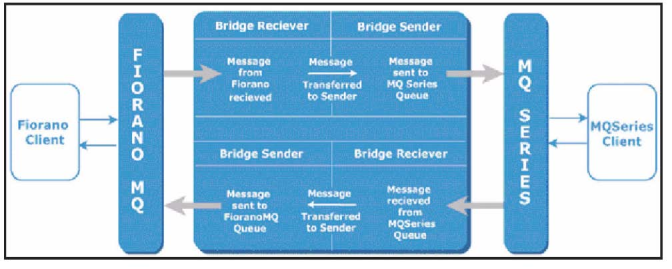Due to lack of a standard communication protocol, every messaging vendor invariably uses a proprietary protocol for client-server data exchange. Lack of "interoperability" across multiple messaging vendors poses serious problems for communication across messaging systems. For instance, FioranoMQ applications cannot push or pop messages to IBM WebSphereMQ queues and vice versa. This lack of interoperability among message queuing systems can be a problem for businesses that merge, particularly when they want to integrate information systems based on different message queuing systems. FioranoMQ solves this problem by "bridging" FioranoMQ with IBM MQ Series, MSMQ, Tibrv and all other JMS providers' products.
FioranoMQ Bridge solves this integration problem by allowing messages to be passed between FioranoMQ and other message queuing systems. If two banks were to merge and needed to integrate their information systems, the management can decide to consolidate all account information on IBM systems that use IBM WebSphereMQ for message exchange. The management would, however, like to have its customers continue using its current ATM system. The ATM system receives requests for account information and dispatches requests to the server system using FioranoMQ messages. Instead of rewriting applications, the FioranoMQ Bridge can be used to forward requests and responses between the two different message queuing systems.
Bridge Architecture
The FioranoMQ Bridge is an open, standards-based, Java component. The FioranoMQ Bridge provides a set of standards-based configurable services that allow messages to be exchanged between FioranoMQ and other message queuing systems.
Communication to any other JMS vendor is done using the standard JMS API. Communication to MSMQ is done using MSMQ Java APIs and communication to TIBCO Rendevous (Tibrv) is done using Tibrv Java APIs. The FioranoMQ Bridge sends messages as JMS Messages to the targeted JMS vendor. The FioranoMQ Bridge is configured using XML-based configuration files that allow a single instance of the Bridge to "bridge" any number of messaging servers.
Messages are pushed to the remote system using the standard JMS API (or MSMQ/Tibrv APIs if the remote system is MSMQ/Tibrv). Additionally, the Bridge creates receivers to asynchronously receive messages from the remote system. The Figure below depicts the flow between a FioranoMQ client and an IBM WebSphereMQ client through the FioranoMQ Bridge.
